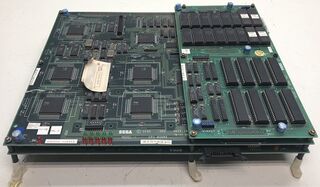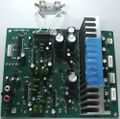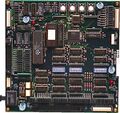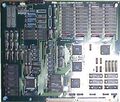Difference between revisions of "Sega Model 1"
From Sega Retro
| Line 20: | Line 20: | ||
==Technical Specifications== | ==Technical Specifications== | ||
| + | {{multicol| | ||
* Board composition: CPU Board, Video Board, ROM Board, I/O Board, Comm Board, Sound Board, Motor Board, Amp Board {{ref|https://github.com/mamedev/mame/blob/master/src/mame/drivers/model1.cpp}} | * Board composition: CPU Board, Video Board, ROM Board, I/O Board, Comm Board, Sound Board, Motor Board, Amp Board {{ref|https://github.com/mamedev/mame/blob/master/src/mame/drivers/model1.cpp}} | ||
* Main [[wikipedia:Central processing unit|CPU]]: [[NEC]] [[wikipedia:NEC V60|V60]] @ 16 MHz {{fileref|Overview of 32-bit V-Series Microprocessor.pdf}}{{fileref|UPD70616ProgrammersReferenceManual.pdf}} | * Main [[wikipedia:Central processing unit|CPU]]: [[NEC]] [[wikipedia:NEC V60|V60]] @ 16 MHz {{fileref|Overview of 32-bit V-Series Microprocessor.pdf}}{{fileref|UPD70616ProgrammersReferenceManual.pdf}} | ||
| − | ** [[wikipedia:Fixed-point arithmetic|Fixed-point arithmetic]]: | + | ** [[wikipedia:Fixed-point arithmetic|Fixed-point arithmetic]]: 32-bit [[wikipedia:Reduced instruction set computing|RISC]] [[wikipedia:Instruction set|instructions]] @ 3.5 [[wikipedia:Instructions per second|MIPS]] |
| − | ** [[wikipedia:Floating-point unit|Floating-point unit]]: [[wikipedia:Single-precision floating-point format|32-bit]] | + | ** [[wikipedia:Floating-point unit|Floating-point unit]]: [[wikipedia:Single-precision floating-point format|32-bit]] & [[wikipedia:Double-precision floating-point format|64-bit operations]] @ 16 MFLOPS |
| − | ** Bus width: 32-bit | + | ** Bus width: [[wikipedia:32-bit|32-bit]] |
| − | * Additional CPU: 3× [[Zilog Z80]] @ 4 MHz {{ref|https://github.com/mamedev/mame/blob/master/src/mame/drivers/model1.cpp}} | + | * Additional CPU: 3× [[Zilog Z80]] @ 4 MHz (8-bit & 16-bit instructions @ 1.74 MIPS) {{ref|https://github.com/mamedev/mame/blob/master/src/mame/drivers/model1.cpp}} |
| + | ** CPU for I/O Board, Comm Board and Motor Board | ||
* [[wikipedia:Direct memory access|DMA]] controllers: [[:File:MB89374 datasheet.pdf|Fujitsu MB89374]], [[:File:MB89396 datasheet.pdf|Fujitsu MB89237A]] {{ref|https://github.com/mamedev/mame/blob/master/src/mame/drivers/model1.cpp}} | * [[wikipedia:Direct memory access|DMA]] controllers: [[:File:MB89374 datasheet.pdf|Fujitsu MB89374]], [[:File:MB89396 datasheet.pdf|Fujitsu MB89237A]] {{ref|https://github.com/mamedev/mame/blob/master/src/mame/drivers/model1.cpp}} | ||
| + | }} | ||
===Sound=== | ===Sound=== | ||
| − | * Sound CPU: Toshiba TMP68000N-10 ([[68000]]) @ 12 MHz {{ref|https://github.com/mamedev/mame/blob/master/src/mame/drivers/model1.cpp}} | + | * Sound CPU: [[wikipedia:Toshiba|Toshiba]] TMP68000N-10 ([[68000]]) @ 12 MHz {{ref|https://github.com/mamedev/mame/blob/master/src/mame/drivers/model1.cpp}} |
* Sound chips: 2× Sega 315-5560 Custom MultiPCM | * Sound chips: 2× Sega 315-5560 Custom MultiPCM | ||
** Audio capabilities: 28 [[Pulse-code modulation|PCM]] channels per chip (one for music, one for sound effects), 56 PCM channels total | ** Audio capabilities: 28 [[Pulse-code modulation|PCM]] channels per chip (one for music, one for sound effects), 56 PCM channels total | ||
| Line 39: | Line 42: | ||
* GPU [[wikipedia:Coprocessor|coprocessors]]: 5× [[Fujitsu]] TGP MB86233 [[wikipedia:Digital signal processor|DSP]] {{ref|http://members.iinet.net.au/~lantra9jp1/gurudumps/m2status/index.html}} @ 16 MHz ([[wikipedia:Geometry pipelines|geometrizer]], [[wikipedia:Rasterisation|rasterizer]],{{ref|https://github.com/mamedev/mame/blob/master/src/mame/video/model1.cpp}} [[wikipedia:Floating point unit|FPU]], [[wikipedia:Arithmetic logic unit|ALU]]) {{fileref|MB86232 datasheet.pdf}} | * GPU [[wikipedia:Coprocessor|coprocessors]]: 5× [[Fujitsu]] TGP MB86233 [[wikipedia:Digital signal processor|DSP]] {{ref|http://members.iinet.net.au/~lantra9jp1/gurudumps/m2status/index.html}} @ 16 MHz ([[wikipedia:Geometry pipelines|geometrizer]], [[wikipedia:Rasterisation|rasterizer]],{{ref|https://github.com/mamedev/mame/blob/master/src/mame/video/model1.cpp}} [[wikipedia:Floating point unit|FPU]], [[wikipedia:Arithmetic logic unit|ALU]]) {{fileref|MB86232 datasheet.pdf}} | ||
** Coprocessor abilities: [[wikipedia:Decimal floating point|Floating decimal point]] operation function, axis rotation operation function, 3D [[wikipedia:Matrix (mathematics)|matrix operation]] function, DMA, T&L (transform, clipping, lighting) {{ref|http://wiki.mamedev.org/index.php/TGP:Index}} | ** Coprocessor abilities: [[wikipedia:Decimal floating point|Floating decimal point]] operation function, axis rotation operation function, 3D [[wikipedia:Matrix (mathematics)|matrix operation]] function, DMA, T&L (transform, clipping, lighting) {{ref|http://wiki.mamedev.org/index.php/TGP:Index}} | ||
| − | ** Fixed-point arithmetic: 32-bit instructions @ 80 MIPS (16 MIPS each) | + | ** Fixed-point arithmetic: 32-bit instructions @ 80 MIPS (16 MIPS each) |
| − | ** Floating-point unit: 32-bit operations @ 80 MFLOPS (16 MFLOPS each) | + | ** Floating-point unit: 32-bit operations @ 80 MFLOPS (16 MFLOPS each) |
** Bus width: 32-bit | ** Bus width: 32-bit | ||
* Display resolution: 496×384 pixels, 24 kHz [[wikipedia:Horizontal scan rate|H-Sync]], [[wikipedia:Progressive scan|progressive scan]] (non-interlaced) {{ref|https://github.com/mamedev/mame/blob/master/src/mame/drivers/model1.cpp}} | * Display resolution: 496×384 pixels, 24 kHz [[wikipedia:Horizontal scan rate|H-Sync]], [[wikipedia:Progressive scan|progressive scan]] (non-interlaced) {{ref|https://github.com/mamedev/mame/blob/master/src/mame/drivers/model1.cpp}} | ||
| Line 49: | Line 52: | ||
* Graphical capabilities: [[wikipedia:Shading|Shading]], [http://www.giantbomb.com/flat-shading/3015-2277/ flat shading], [[wikipedia:Diffuse reflection|diffuse reflection]], [[wikipedia:Specular reflection|specular reflection]], 2 layers of background [[wikipedia:Scrolling|scrolling]], [[wikipedia:Alpha blending|alpha blending]], [[wikipedia:Alpha compositing|alpha channel]], [[wikipedia:Computer graphics lighting|lighting]] {{ref|https://github.com/mamedev/mame/blob/master/src/mame/video/model1.cpp}} | * Graphical capabilities: [[wikipedia:Shading|Shading]], [http://www.giantbomb.com/flat-shading/3015-2277/ flat shading], [[wikipedia:Diffuse reflection|diffuse reflection]], [[wikipedia:Specular reflection|specular reflection]], 2 layers of background [[wikipedia:Scrolling|scrolling]], [[wikipedia:Alpha blending|alpha blending]], [[wikipedia:Alpha compositing|alpha channel]], [[wikipedia:Computer graphics lighting|lighting]] {{ref|https://github.com/mamedev/mame/blob/master/src/mame/video/model1.cpp}} | ||
* [[wikipedia:Digital geometry|Geometric]] performance: 180,000 polygons/sec (with all effects), 540,000 vectors/sec | * [[wikipedia:Digital geometry|Geometric]] performance: 180,000 polygons/sec (with all effects), 540,000 vectors/sec | ||
| − | * [[wikipedia:Fillrate| | + | * Rendering [[wikipedia:Fillrate|fillrate]]: 36 million [[pixel]]s/sec |
}} | }} | ||
| Line 58: | Line 61: | ||
** Main RAM: 480 KB (at least 156 KB SRAM) | ** Main RAM: 480 KB (at least 156 KB SRAM) | ||
*** CPU Board: 324 KB (320 KB main, 4 KB comm) | *** CPU Board: 324 KB (320 KB main, 4 KB comm) | ||
| − | *** Comm Board: 12 KB SRAM (8 KB SRAM, 4 KB [[wikipedia:Dual-ported RAM|Dual-Port]] SRAM) {{fileref| | + | *** Comm Board: 12 KB SRAM (8 KB SRAM, 4 KB [[wikipedia:Dual-ported RAM|Dual-Port]] SRAM) {{fileref|MB8421 datasheet.pdf}}{{fileref|MB8431 datasheet.pdf}} |
*** Other boards: 144 KB [[SRAM]] (128 KB ROM Board, 8 KB I/O Board, 8 KB Motor Board) | *** Other boards: 144 KB [[SRAM]] (128 KB ROM Board, 8 KB I/O Board, 8 KB Motor Board) | ||
** [[VRAM]]: 2232 KB (at least 1464 KB SRAM) | ** [[VRAM]]: 2232 KB (at least 1464 KB SRAM) | ||
| Line 69: | Line 72: | ||
===Bandwidth=== | ===Bandwidth=== | ||
| − | * System RAM bandwidth: | + | * System RAM bandwidth: 432 MB/sec {{ref|https://github.com/mamedev/mame/blob/master/src/mame/drivers/model1.cpp}} |
| − | ** Main RAM: 54.495675 MB/sec (32-bit, 14.285714 MHz) {{fileref|MB86232 datasheet.pdf}} | + | ** Main RAM: 65.939767 MB/sec |
| + | *** CPU Board: 54.495675 MB/sec (32-bit, 14.285714 MHz) {{fileref|MB86232 datasheet.pdf}} | ||
| + | *** Other boards: 11.444092 MB/sec (3× 8-bit, 4 MHz) {{fileref|MB8464A datasheet.pdf}}{{fileref|MB8432 datasheet.pdf}}{{fileref|MB8431 datasheet.pdf}} | ||
** VRAM: 346.790661 MB/sec (5× 32-bit, 18.181818 MHz) {{fileref|HM65256B datasheet.pdf}} | ** VRAM: 346.790661 MB/sec (5× 32-bit, 18.181818 MHz) {{fileref|HM65256B datasheet.pdf}} | ||
| − | ** | + | ** Audio RAM: 19.073486 MB/sec (16-bit, 10 MHz) {{fileref|MB8464A datasheet.pdf}} |
==List of Sega Model 1 Games== | ==List of Sega Model 1 Games== | ||
Revision as of 20:00, 21 November 2015

| |||||
| Sega Model 1 | |||||
|---|---|---|---|---|---|
| Manufacturer: Sega | |||||
|
The Sega Model 1 is an arcade system board released by Sega in 1992. It is the successor to the Sega System 32 arcade boards, and was succeeded by the Sega Model 2 series. It was Sega's first hardware designed for 3D polygon graphics.
Originally, the Model 1 was simply known as the CG Board, but was retroactively given the Model 1 name after work on the Model 2 began.
Contents
Hardware
It began development in 1990,[1] with Yu Suzuki's Sega AM2 team involved in its development from the drawing board.[2] The Model 1 was intended to compete with Namco's System 21; Namco was then the market leader in polygonal 3D video games, with titles such as Galaxian³ and Starblade.[3] The Model 1 was eventually released in 1992, debuting with Virtua Racing. While it was a significant improvement over the System 21, the Model 1 hardware was expensive, and only a few games were developed for the platform.
Contrary to popular opinion, Lockheed Martin was not involved with the development of the Model 1, but it was developed internally at Sega, before Lockheed Martin became involved with the development of the Sega Model 2, according to former Lockheed Martin employee, Real3D's Jon Lenyo, in 1998. [1]
Technical Specifications
- Board composition: CPU Board, Video Board, ROM Board, I/O Board, Comm Board, Sound Board, Motor Board, Amp Board [4]
- Main CPU: NEC V60 @ 16 MHz [5][6]
- Fixed-point arithmetic: 32-bit RISC instructions @ 3.5 MIPS
- Floating-point unit: 32-bit & 64-bit operations @ 16 MFLOPS
- Bus width: 32-bit
- Additional CPU: 3× Zilog Z80 @ 4 MHz (8-bit & 16-bit instructions @ 1.74 MIPS) [4]
- CPU for I/O Board, Comm Board and Motor Board
- DMA controllers: Fujitsu MB89374, Fujitsu MB89237A [4]
Sound
- Sound CPU: Toshiba TMP68000N-10 (68000) @ 12 MHz [4]
- Sound chips: 2× Sega 315-5560 Custom MultiPCM
- Audio capabilities: 28 PCM channels per chip (one for music, one for sound effects), 56 PCM channels total
- Sound timer: Yamaha YM3834 @ 8 MHz
Graphics
- Graphics board: Sega 837-7894 171-6080D VIDEO PCB @ 36 MHz [7]
- GPU coprocessors: 5× Fujitsu TGP MB86233 DSP [8] @ 16 MHz (geometrizer, rasterizer,[9] FPU, ALU) [10]
- Coprocessor abilities: Floating decimal point operation function, axis rotation operation function, 3D matrix operation function, DMA, T&L (transform, clipping, lighting) [11]
- Fixed-point arithmetic: 32-bit instructions @ 80 MIPS (16 MIPS each)
- Floating-point unit: 32-bit operations @ 80 MFLOPS (16 MFLOPS each)
- Bus width: 32-bit
- Display resolution: 496×384 pixels, 24 kHz H-Sync, progressive scan (non-interlaced) [4]
- Overscan resolution: 656×496 pixels
- Frame rate: 30–60 frames/sec
- Color palette: 16,777,216 (16-bit high color depth and 256 luminance levels) [9]
- Colors on screen: 190,464 (496×384)
- Graphical capabilities: Shading, flat shading, diffuse reflection, specular reflection, 2 layers of background scrolling, alpha blending, alpha channel, lighting [9]
- Geometric performance: 180,000 polygons/sec (with all effects), 540,000 vectors/sec
- Rendering fillrate: 36 million pixels/sec
Memory
- Memory: Up to 38,142 KB (5984 KB main, 23,646 KB video, 8512 KB audio)
- System RAM: 2776 KB (1896 KB high-speed SRAM) [4]
- Main RAM: 480 KB (at least 156 KB SRAM)
- VRAM: 2232 KB (at least 1464 KB SRAM)
- CPU Board: 768 KB (128 KB display lists, 576 KB tiles, 64 KB color)
- Video Board: 1464 KB SRAM
- Audio RAM: 64 KB (16 KB SRAM)
- Internal DSP cache: 30 KB (6 KB per DSP) [10]
- Game ROM: Up to 35,336 KB (5504 KB main, 21,384 KB video,[14] 8448 KB audio)[15]
Bandwidth
- System RAM bandwidth: 432 MB/sec [4]
List of Sega Model 1 Games
- Virtua Racing (1992)
- Star Wars Arcade (1993)
- Virtua Fighter (1993)
- Wing War (1994)
- Sega VR-1 (1994)
- Dennoo Senki Net Merc (1995)
Gallery
| Sega arcade boards |
|---|
| Originating in arcades |
|
77
78
79
80
81
82
83
84
85
86
87
88
89
90
91
92
93
94
95
96
97
98
99
|
| Console-based hardware |
|
84
85
86
87
88
89
90
91
92
93
94
95
96
97
98
99
00
01
02
03
04
05
06
07
08
09
10
11
12
13
14
|
| PC-based hardware |
|
05
06
07
08
09
10
11
12
13
14
15
16
17
18
19
20
21
22
23
|






